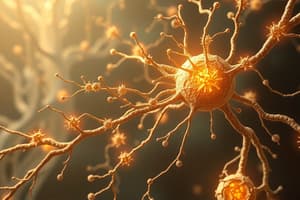Podcast
Questions and Answers
During which phase of the action potential is rapid depolarization primarily occurring?
During which phase of the action potential is rapid depolarization primarily occurring?
- Phase 3
- Phase 2
- Phase 0 (correct)
- Phase 1
What is the primary effect of K+ current during repolarization?
What is the primary effect of K+ current during repolarization?
- Moves Vm closer to EK (correct)
- Moves Vm closer to ENa
- Increases Na+ influx
- Causes hyperpolarization of Vm
How does the positive influx of Na+ and Ca2+ ions primarily affect the membrane potential?
How does the positive influx of Na+ and Ca2+ ions primarily affect the membrane potential?
- It causes partial repolarization
- It creates a depolarizing current (correct)
- It stabilizes the resting potential
- It results in a hyperpolarizing effect
What does the formula IX = (Vm - EX) / R represent in the context of ionic currents?
What does the formula IX = (Vm - EX) / R represent in the context of ionic currents?
What is the primary ionic current contributing to the plateau phase of the action potential?
What is the primary ionic current contributing to the plateau phase of the action potential?
What primarily determines the rapid depolarization phase of the ventricular action potential?
What primarily determines the rapid depolarization phase of the ventricular action potential?
During which phase of the ventricular action potential is the balance of influx and efflux of ionic currents seen?
During which phase of the ventricular action potential is the balance of influx and efflux of ionic currents seen?
Which ion current is responsible for the early repolarization in Phase 1 of the ventricular action potential?
Which ion current is responsible for the early repolarization in Phase 1 of the ventricular action potential?
What is the primary ionic current responsible for repolarization in Phase 3?
What is the primary ionic current responsible for repolarization in Phase 3?
Which of the following best describes the ionic conditions during Phase 4 of the ventricular action potential?
Which of the following best describes the ionic conditions during Phase 4 of the ventricular action potential?
Flashcards are hidden until you start studying
Study Notes
Membrane Potentials and Ionic Currents
- Resting membrane potential (Vm) is influenced by equilibrium potentials (Ex) for ions like Na⁺ (+72 mV), K⁺ (-88 mV), and Ca²⁺ (+123 mV).
- Ionic currents (Ix) are determined by the difference between Vm and Ex, divided by membrane resistance (R): Ix = (Vm - Ex)/R.
- Inward currents (Na⁺ and Ca²⁺) depolarize the membrane, moving Vm closer to ENa and ECa.
- Outward currents (K⁺) repolarize the membrane, moving Vm closer to EK.
- Specific currents include fast Na⁺ current (INa), L-type Ca²⁺ current (ICa), transient outward K⁺ current (Ito), delayed rectifier K⁺ current (IK), and inward rectifier K⁺ current (IK1).
Ventricular Action Potential Phases
- Phase 0 (Rapid Depolarization): Driven mainly by INa.
- Phase 1 (Partial Repolarization): Involves Ito.
- Phase 2 (Plateau): A balance between inward ICaL and outward IK.
- Phase 3 (Repolarization): Primarily due to IK and IK1.
- Phase 4 (Resting Potential): Maintained by IK1; Vm close to EK.
Ionic Concentrations and Equilibrium Potentials
- Intracellular and extracellular concentrations of Na⁺, K⁺, and Ca²⁺ significantly influence their equilibrium potentials and thus the membrane potential. Specific values are provided in the text for each ion type.
Maintaining Ionic Gradients
- Na⁺/K⁺ ATPase (3 Na⁺ out for 2 K⁺ in) and Na⁺/Ca²⁺ exchange (NCX, 3 Na⁺ in for 1 Ca²⁺ out) are crucial for maintaining ionic concentration gradients.
Cardiac Action Potential and Ion Channels
- Cardiac action potentials result from the interplay of voltage- and time-dependent ion channels.
- Threshold potential triggers the upstroke of the action potential.
Intrinsic Pacemaker Rate
- The sinoatrial (SA) node is the dominant pacemaker, with a rate of 100-120 bpm at rest.
- Atrioventricular (AV) node rate is 70-90 bpm.
- Purkinje fibers and ventricular myocardium exhibit intrinsic rates are of 30-40 bpm.
- Autonomic nervous system influences the intrinsic heart rate; complete autonomic blockade reveals the intrinsic rate.
Functional Syncytium and Excitation Propagation
- The myocardium functions as a syncytium due to gap junctions in intercalated disks, allowing coordinated contraction.
- Depolarization spreads through gap junctions, creating intracellular and extracellular currents.
Electrocardiogram (ECG) Waveforms
- ECG waveforms are determined by:
- Mass of tissue depolarizing/repolarizing (larger mass = larger dipole).
- Conduction velocity (affects timing and duration).
- Vectorial orientation of the cardiac dipole relative to the recording lead.
- Distance between electrodes and the dipole.
- The QRS complex is larger than the P wave because ventricular mass is greater than atrial mass.
Studying That Suits You
Use AI to generate personalized quizzes and flashcards to suit your learning preferences.




